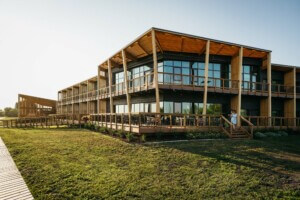The first time Israeli Canadian American architect Moshe Safdie went to Singapore, he was invited by a shipbuilder. It was the late 1970s, and the industry was down. Singaporean businessman Robin Loh wanted to try his hand at developing prefabricated housing with the young mind who had designed Habitat 67, a prototype for factory-built housing in Montreal. The meeting was successful, and in 1985, Safdie Architects’s Ardmore Habitat condominium building was constructed just off Singapore’s prestigious Orchard Road, featuring two 17-story towers of modular units stacked around a central atrium that opened to a bilevel shared garden. The concept created a sort of vertical version of Habitat. Unfortunately, the site was rezoned, the building demolished, and a larger, cheaper-looking replacement rose in 2010, almost cruelly named Ardmore II.
This sort of erasure is common in Singapore, a young country just beginning to embrace preservation of its modern and postmodernist architectural heritage while facing competing interests: government goals for nationwide net-zero emissions by 2050 that could be more easily achieved with new construction, and ambitions to become a “global player,” which requires an iconic contemporary skyline. Interestingly, Singapore is pursuing both aims with Safdie’s help.

I experienced the architect’s contributions to the nation’s urban fabric as soon as I stepped off a plane there in March and into the 1,460,663-square-foot Jewel entertainment and shopping complex. The complex is part of his design of Changi Airport, completed in 2019 with partner Jaron Lubin. Centered around the world’s tallest indoor waterfall and surrounded by gardens and 5 stories of boutiques, eateries, play areas, and more, the asymmetrical torus-shaped building has become a must-visit attraction. But the public project’s concept was surprisingly born out of a cultural tradition: Singaporean schoolchildren who did not have air-conditioning at home would escape the heat by doing homework at the chilled airport. Jewel uses an energy-efficient displacement ventilation system, so even though most households have AC units today, locals still prefer to gather in the public realm.
Located near the equator, Singapore has a tropical climate. Humid and hot most months, it’s brutal to endure the midday sun for longer than the walk to lunch at an open-air hawker market. But that jaunt you do take will most likely be a biophilic one: The entire city-state is lush and manicured, even in its most urban areas. It makes the warmest days and the milder nights, when Singaporeans congregate in public spaces outside, a little more pleasant. It also informs every project built there, from public housing to icons like Safdie’s Marina Bay Sands.

“The whole idea of a green city was [former prime minister] Lee Kuan Yew’s pet project,” Safdie told AN, referring to the authoritarian environmental vision of Singapore as a Garden City, which Yew kicked off in 1970 with a policy to plant 55,000 new trees. “There is a certain kind of national pride around it that’s fascinating,” he continued after we toured Safdie’s newest project in Singapore, the Surbana Jurong campus in a suburban business district. This massive 742,000-square-foot building, designed with partners Charu Kokate, David Brooks, and Jeffrey Huggins, employs both passive and active sustainability features, including a self-shading prefabricated design, rainwater and solar energy harvesting, and an underfloor air distribution system to achieve the country’s first-ever Green Mark Platinum Super Low Energy status. What neighbors will notice most is the 43,500-square-foot, entirely public, 24-hour ground floor—a 665-foot-long pedestrian thoroughfare planted with a full-size indoor garden. Extensive bike lanes and walking paths will soon surround it, too.


As we traversed the city together, making stops at his recent work—Marina Bay Sands; the SJ campus; the Singapore Edition hotel, where I spent four nights in this hybrid of Ian Schrager sleek and Safdie sustainability; and adjacent Boulevard 88 luxury residences with a smaller-scale MBS infinity pool—clients and designers alike were excited to meet the architect. On a quick jaunt to the Urban Redevelopment Authority, Singapore’s planning office, I watched a planning minister introduce him to Mok Wei Wei, one of the country’s most important local architects. (All significant architectural designs in Singapore are first reviewed by a group of local peers, so Wei Wei may have been a jury member for Safdie’s current project, a Marina Bay Sands expansion including a fourth tower, arena, and additional casino floors.)
From his earliest works, there seems to have been a synergy between Safdie and Singapore. At the least, he has found a willing sustainability partner in the Garden City. It feels like “for everyone a garden,” his design philosophy, which originated with Habitat 67, is possible there. What’s needed now is a trickle-down effect to the government-sponsored Housing & Development Board estates.

But he’s also helped give the city-state what it has long desired: visibility. The original brief for Marina Bay Sands called for “a cultural building, which in itself will become an icon for the identity of Singapore,” Safdie revealed to me. “When they said, ‘We want something that will be as famous as Sydney Opera House,’ I said, ‘They’re dreaming,’” he continued. “I think it is, at this point, probably as famous as Sydney Opera House, maybe more.”
During our last dinner together, at the Italian restaurant on the Marina Bay Sands rooftop, I asked Safdie if he feels that Singapore’s long history with foreign architects has made its planning department more open to his work. Before he agreed, Safdie, now 85, credited a few who paved the way: Paul Rudolph, John Portman, Kenzo Tange, and I. M. Pei. None, however, made the city a destination through their architecture quite like Safdie.
Elizabeth Fazzare is a New York–based editor and journalist who covers architecture, design, culture, and travel.











